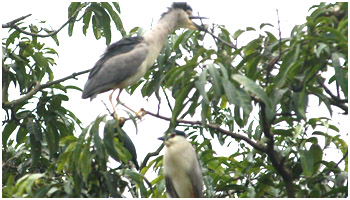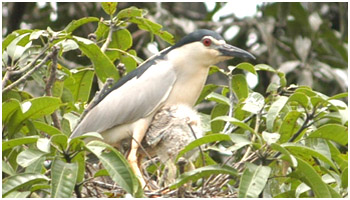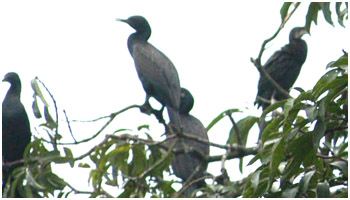 |

By the second week of May, the atmosphere of this scenic islet changes dramatically. The winged visitors arrive in hordes and the air is vibrant with birdcalls. The heronry bustles with activity. Cormorants fly in from different directions with twigs and sprigs in their beaks for nest-building. The herons don their attractive ‘wedding dresses’ (breeding plumage) and in courtship display, flaunt the silky crests and plumes as they try to woo their mates. After pair formation, the mates work together to complete the nest. Eggs are laid in May-June. Once they hatch, the parents shuttle between the feeding grounds of the nearby wetlands and the nesting colony bringing in fish to feed the hungry nestlings. The cacophony at the heronry is at its crescendo during this period, contributed greatly by the omnipresent and opportunistic House Crows waiting to steal morsels of food from the nesting birds. By early October, the nestlings are ready to fledge and the birds bid adieu to Pamburuthi, only to return again next season. This cycle has been going on for years.
The heronry in full swing is a sight worth going miles to see!!
 |
Even during the non-breeding season (November to April), Pamburuthi is not without excitement. As dusk arrives, wave after wave of snowy white birds fly in from different directions to the islet and settle on the trees and coconut palms. These are egrets, which use this place as their night roost in hundreds, along with numerous crows in a sharp contrast of black and white. Four species of egrets are found here - Little Egret Egretta garzetta, Large Egret Casmerodius albus and Median Egret Mesophoyx intermedia and Cattle Egret Bubulcus ibis. Interestingly, the egrets have not been observed to nest in north Kerala, though they breed in the southern districts and Wayanad.
 |
| From Untitled Album |
Recently, there was some concern among the residents and the local birdwatchers on the threat posed to the birds of the heronry by poachers who come from outside. Under the initiative of the Malabar Natural History Society (MNHS) a meeting of the local people, ornithologists and the officials of the Kerala Forest and Wildlife Department was convened on 10 th September 2005. In the meeting, the importance of the heronry and the need for its conservation were highlighted. The residents, who are keen in conserving the heronry, decided to be vigilant against poaching or any such disturbance. Many youngsters of the area wanted to know more about the birds. There were discussions on how to utilize the ‘guano’ better.
No comments:
Post a Comment